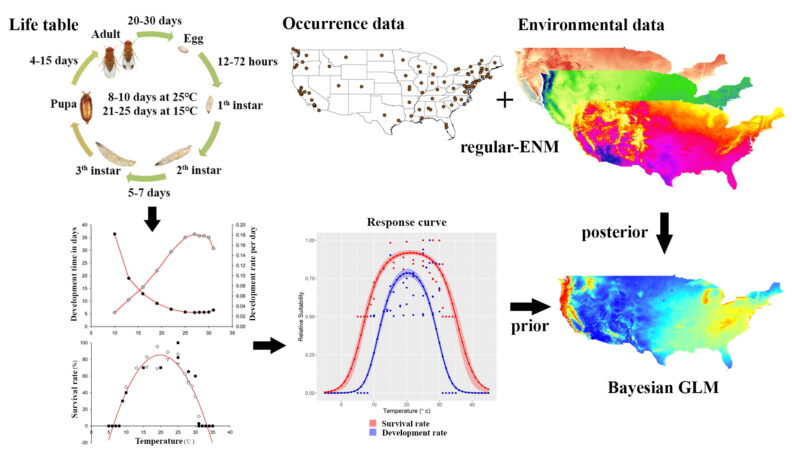The ZHU Lab
Welcome to Dr. Gengping Zhu lab !
The Zhu Lab is based in Department of Entomology at Washington State University, Pullman, Washington State.
We combine statistical analyses, mathematical modelling, and field survey to examine basic and applied questions in regional and global invasive insect management, and functional insect biodiversity and conservation. We are interest in insect niche and distribution modelling, and their applications in insect biodiversity and conservation.
Current research focus on three areas:
1. Prevent establishment and mitigate impacts of invasive insect species in the Pacific Northwest
The mild climate in the Pacific Northwest (i.e., warm but not hot, cool but not cold, with lots of moisture) has provided suitable conditions for many invasive species, where intense human activity in the coastal areas (e.g., Seattle, Portland) have facilitated their arrival, resulting in ever-increasing establishments of invasive species every year in this area, and great economic loss. Developing approaches to successfully detect, predict, and mitigate invasive species is a necessary step to advance effective management as early detection and rapid response practices are the most cost-effective and efficient method. We aim to employ state-of-the-art niche and distribution techniques to estimate potential distribution and dispersal of these invasive species, to facilitate their early detection and eradication. Here is an example of habitat suitability prediction of Northern Giant Hornet (Zhu et al. 2021), the establishment of this hornet in Washington State is of great concern to bee industry.

Increasing intensities of yellow represent increasing climate suitability, and increasing blue represent increasing severity of invasions due to human activity.
2. Improve ecological modeling techniques for invasion risk assessment under climate change
Accurately predicting the distribution of emerging invasive species is crucial for early detection and eradication. While ecological niche models are often used to forecast invasions, such models are limited when invasive populations of a species have realized niches that differ from native populations, or when invasive populations are not at equilibrium. One technique to potentially overcome these challenges is to incorporate physiological responses of invaders to abiotic factors into ecological niche models, although few studies have assessed whether such approaches are effective. We addressed this by determining whether incorporating physiological data from life table analyses of an invasive insect, Drosophila suzukii, improved predictions of ecological niche models (Zhu et al. 2021). We show that incorporating physiological responses of D. suzukii to temperature into our ecological niche models increased transferability of predictions from the native to the invasive range, while also reducing uncertainty of predictions. Moreover, physiological combined models performed best when equilibrium assumptions were violated. Our study suggests ecological niche models that incorporate data on physiological responses of invaders to abiotic factors provides a means to develop more effective and timely invasive pest distributional models.

Developmental and survival rates (bottom left) derived from insect life table (top left) served as a prior for Bayesian GLM (bottom right) (Zhu et al. 2021).
3. Diversity and conservation of functional insects (i.e., nature insect enemy, bee, pollinator)
Invasive species are often difficult to manage because they invade areas where they escape their nature enemies. While both classical and conservation biological control can be implemented to manage invasive species, effective biological control for invasive species is often limited by a lack of available data on the distributions of invaders and natural enemies during the course of invasions. The nature enemy is an overlooked group, they nonetheless provide important function in health ecosystem. Releasing natural enemies or parasites of an exotic insect is a successfully proven method to reduce pest populations. Assessing the geographic dimensions of biological control, by comparing climate niche spaces and geographic distributions of invasive species and their nature enemy, is a crucial step for planning enemy’s releasement because its success largely depends on the released species habitat suitability. Invasive species and their nature enemies would show different kinds of overlaps in ecological and geographic dimensions, the degree and type of distribution and niche overlaps can be quantified and used to assess interspecific competition for biocontrol. The geographic projection of these niche spaces would provide sample plans on where to deploy traps to confirm distribution, where to settle conservation plan, or where to release for biological control.

Overlap in predicted habitat suitability for Halyomorpha halys and Trissolcus japonicus (left) and H. halys and Nosema maddoxi (right).
Overlaps were measured as Schoener’s D (range from 0 to 1), higher D values indicate greater niche overlap (Zhu et al. 2023 in sub).
Another important functional insect group is bees/pollinators, these insects are well studied however they were poorly protected. Protected areas continue to occupy a central role in conservation strategies in this era of global change, however, the gaps in protected area coverage mean some species and habitats receive inadequate protection, future climate change will further complicate this conservation picture; another conservation strategy is by climate resilient, which was developed by The Nature Conservancy. However, the effectiveness of these approaches to safeguard bee/pollinator biodiversity were questioned, which might be quite dependent dimensions of biodiversity. The Pacific Northwest is also frequently impacted by wildfires, we nonetheless lack baseline knowledge on which bee species and to what extent their suitable habitats were impacted by these wildfires. I am seeking funding to support graduate student to develop habitat suitability models for bees and pollinators in examine whether protected area were able to safeguard US bee habitat, and wildfire burning on bee habitat.